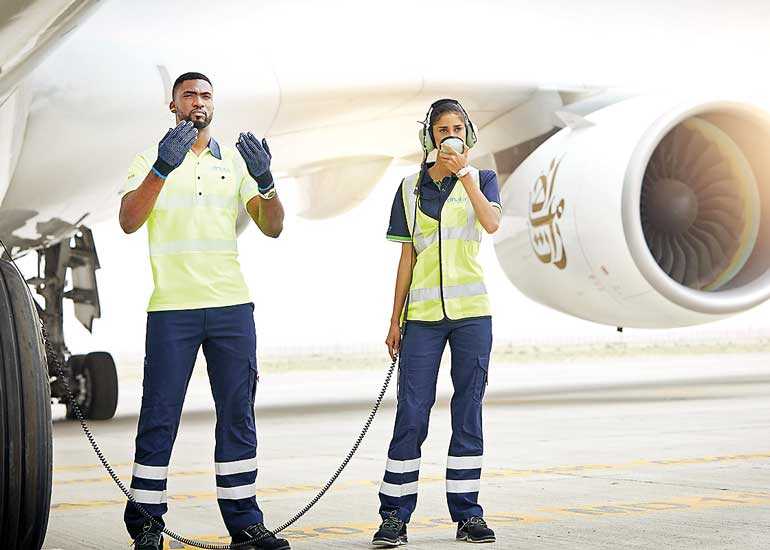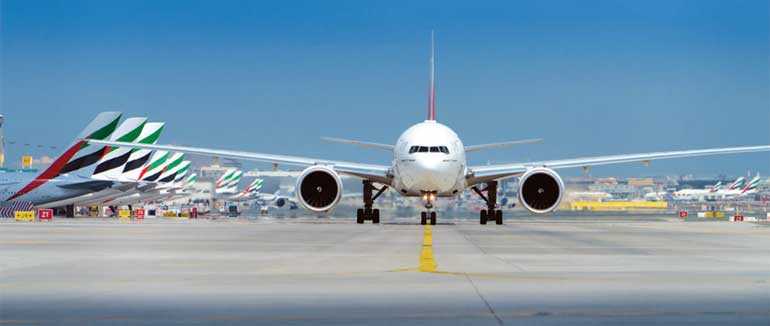Sunday Dec 21, 2025
Sunday Dec 21, 2025
Monday, 13 May 2019 00:00 - - {{hitsCtrl.values.hits}}


Expands global footprint with acquisition of Qantas catering in Australia and 121 Inflight catering business in the Americas, adds new facilities and service capabilities across its airport operations, catering, and travel services divisions
The Emirates Group last week announced its 31st consecutive year of profit and steady business expansion.
|
Emirates Airline and Group Chairman and Chief Executive Sheikh Ahmed bin Saeed Al Maktoum announced Emirates and dnata’s 2018/19 financial performance, including the Group’s 31st consecutive year of profit |
The Emirates Group posted a profit of AED 2.3 billion (US$ 631 million) for the financial year ended 31 March 2019, down 44% from last year. The Group’s revenue reached AED 109.3 billion (US$ 29.8 billion), an increase of 7% over last year’s results. The Group’s cash balance was AED 22.2 billion (US$ 6.0 billion), down 13% from last year mainly due to large investments into the business, including significant acquisitions and payment of last year’s AED 2 billion (US$ 545 million) dividend.
In line with the overall profit, the Group declared a dividend of AED 500 million (US$ 136 million) to the Investment Corporation of Dubai for 2018-19.
Chairman and Chief Executive, Emirates Airline and Group Sheikh Ahmed bin Saeed Al Maktoum said: “2018-19 has been tough, and our performance was not as strong as we would have liked. Higher oil prices and the strengthened US dollar eroded our earnings, even as competition intensified in our key markets. The uptick in global airfreight demand from the previous year appears to have gone into reverse gear, and we also saw travel demand weaken, particularly in our region, impacting both dnata and Emirates.
“Every business cycle is different, and we continue to work smart and hard to tackle the challenges and take advantage of opportunities. Our goal has always been to build a profitable, sustainable, and responsible business based in Dubai, and these principles continue to guide our decisions and investments. In 2018-19, Emirates and dnata delivered our 31st consecutive year of profit, recorded growth across the business, and invested in initiatives and infrastructure that will secure our future success.”
In 2018-19, the Group collectively invested AED 14.6 billion (US$ 3.9 billion) in new aircraft and equipment, the acquisition of companies, modern facilities, the latest technologies, and staff initiatives, a significant increase over last year’s investment spend of AED 9.0 billion (US$ 2.5 billion).
In February, Emirates announced a commitment for 40 A330-900s and 30 A350-900s worth US$ 21.4 billion at list prices in an agreement signed with Airbus, to be delivered from 2021 and 2024 respectively. The airline will also receive 14 more A380 deliveries from 2019 until the end of 2021, taking its total A380 order book to 123 units.
dnata’s key investments during the year included: the acquisitions of Q Catering and Snap Fresh in Australia, and 121 Inflight Catering in the US; the buy-out of shares to become the owner of Dubai Express, Freightworks LLC; and a 51% majority stakeholder of Bolloré Logistics LLC, UAE; the build of new cargo and pharma handling facilities in Belgium, the US, the UK, the Netherlands, Australia, Singapore and Pakistan; the acquisition of German tour operator Tropo, and a majority stake in BD4travel, a company providing artificial intelligence driven IT solutions in the travel sector.
Across its more than 120 subsidiaries, the Group’s total workforce increased by 2% to 105,286, representing over 160 different nationalities, mainly influenced by dnata’s new acquisitions and its international business expansion.
Sheikh Ahmed said: “In 2018-19, we were steadfast with our cost discipline while expanding our business and growing revenues. By slowing the recruitment of non-operational roles, and implementing new technology systems and new work structures, we’ve improved productivity and retarded manpower cost increases.”
He concluded: “It’s hard to predict the year ahead, but both Emirates and dnata are well positioned to navigate speed bumps, as well as to compete and succeed in the global marketplace. We must continually up our game, that’s why we invest in our people, technology, and infrastructure to help us maintain our competitive edge. As a responsible business, we also invest resources towards supporting communities, conservation and environmental initiatives, as well as incubating talent and innovation that will propel our industry in the future.”
Emirates performance
Emirates’ total passenger and cargocapacity crossed the 63 billion mark, to 63.3 billion ATKMs at the end of 2018-19, cementing its position as the world’s largest international carrier. The airline moderately increased capacity during the year over 2017-18 by 3%, with a focus on yield improvement.
Emirates received 13 new aircraft during the financial year, comprising of seven A380s and six Boeing 777-300ERs, including the last 777-300ER on its order book. The next 777 delivery is planned for 2020, when Emirates receives its first 777X aircraft.
During 2018-19, Emirates phased out 11 older aircraft, bringing its total fleet count to 270 at the end of March. This fleet roll-over involving 24 aircraft was again one of the largest managed in a year, keeping Emirates’ average fleet age at a youthful 6.1 years.
It reinforces Emirates’ strategy to operate a young and modern fleet, and live up to its “Fly Better” brand promise as modern aircraft are better for the environment, better for operations, and better for customers.
During the year, Emirates launched three new passenger destinations: London Stansted (UK), Santiago (Chile) and Edinburgh (Scotland), and reinstated services to SabihaGokcen (Turkey). It also added flight capacity to 14 existing destinations and upgraded capacity to six cities, offering customers more choice of flight timings and onward connections.
Supplementing its organic network growth, Emirates expanded its global connectivity and customer proposition through new codeshare agreements signed with Jetstar Pacific and China Southern Airlines. It also enhanced its commercial strategic partnership with South African Airways.
Despite stiff competition across its key markets, Emirates increased its revenue by 6% to AED 97.9 billion (US$ 26.7 billion). The relative strengthening of the US dollar against currencies in many of Emirates’ key markets had an AED 572 million (US$ 156 million) negative impact to the airline’s bottom line, a stark contrast to the previous year’s positive currency impact of AED 661 million (US$ 180 million).
Total operatingcosts increased by 8% over the 2017-18 financial year. The average price of jet fuel climbed by a further 22% during the financial year after last year’s 15% increase. Including a 3% higher uplift in line with capacity increase, the airline’s fuel bill increased substantially by 25% over last year to AED 30.8 billion (US$ 8.4 billion). This is the biggest-ever fuel bill for the airline, accounting for 32% of operating costs, compared to 28% in 2017-18. Fuel remained the biggest cost component for the airline.
Against a backdrop of high fuel prices, strong competitive pressure, and unfavourable currency impact, the airline reported a profit of AED 871 million (US$ 237 million), a decline of 69% over last year’s results, and a profitmargin of 0.9%.
Overall passenger traffic remained steady, as Emirates carried 58.6 million passengers (up 0.2%). With seat capacity increasing by 4%, the airline achieved a Passenger Seat Factor of 76.8%. The slight decline in passenger seat factor compared to last year’s 77.5%, reflects the impact of slowing regional economies on travel demand, and strong competition in many markets.
An increase in market fares and a favourable class mix helped support a passenger yield increase of more than 3% to 26.2 fils (7.1 US cents) per Revenue Passenger Kilometre (RPKM), although the full impact was partly offset by the strengthening of the US dollar against most currencies.
During the year, Emirates raised AED 14.2 billion (US$ 3.9 billion) to fund its fleet growth, using a combination of term loans, finance and operating leases.
Emirates closed the financial year with a healthy level of AED 17.0 billion (US$ 4.6 billion) of cash assets.
Revenue generated from across Emirates’ six regions continues to be well balanced, with no region contributing more than 30% of overall revenues. Europe was the highest revenue contributing region with AED 28.3 billion (US$ 7.7 billion), up 6% from 2017-18. East Asia and Australasia follows closely with AED 26.6 billion (US$ 7.2 billion), up 5%. The Americas region recorded revenue growth at AED 14.5 billion (US$ 3.9 billion), up 8%. Africa revenue increased by 9% to AED 10.2 billion (US$ 2.8 billion), whereas Gulf and Middle East revenue decreased by 3% to AED 8.3 billion (US$ 2.3 billion). West Asia and Indian Ocean revenue increased by 6% to AED 8.1 billion (US$ 2.2 billion).
Emirates SkyCargo continued to deliver a strong performance in a highly competitive market with dampening demand, contributing to 14% of the airline’s total transport revenue.
In an airfreight market facing unrelenting downward pressure on yields and slowing demand, Emirates’ cargo division reported a revenue of AED 13.1 billion (US$ 3.6 billion), an increase of 5% over last year, while tonnage carried slightly increased by 1% to reach 2.7 million tons.
Freight yield per Freight TonneKilometre (FTKM) for the 2nd consecutive year increased by a further 3%, demonstrating Emirates SkyCargo’s ability to retain and win customers on value despite fuel price increases, and a weakened demand in many markets.
Emirates’ hotels recorded revenue of AED 669 million (US$ 182 million), a decline of 10% over last year with competition further on the rise in the UAE market impacting average room rates and occupancy levels.
For 2018-19, dnata recorded its most profitable year with AED 1.4 billion (US$ 394 million) profit. This includes gains from a one-time transaction where dnata divested its 22% stake in the travel management company Hogg Robinson Group (HRG), during HRG’s acquisition by Amex Travel Business Group. Without this one-time transaction, dnata profits will be down 15% compared to the same period last year.
dnata’stotalrevenue grew to AED 14.4 billion (US$ 3.9 billion), up 10%. This reflects its continued business growth across its four business divisions - both organic through customer retention and new contract wins; as well as via its new acquisitions. dnata’s international business now accounts for 70% of its revenue.